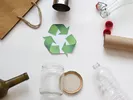By continuing to use this site, you agree to our use of cookies.
Understanding Your City’s Recycling Program
Sep 18, 2019
In:
Figuring out how to recycle
So you’re at a quick-service restaurant with a water bottle, a plate of food, a napkin and utensils. After finishing the meal, you approach the bins. One is marked for garbage, one for compost, one for plastics, and one for paper. Where does each item go? Have you ever stood for too long reading the signs and trying to decide what to do? Well, rest assured you don’t need a degree in recycling to make a difference. Whether you’re trying to start a good habit and reduce trash, or you’ve just moved to a new town that has recycling available, this guide will help sort it all out.

The basics
It’s important to begin with the ultimate goal in mind. The saying goes, “Reduce, reuse, recycle.” The overall goal should be to reduce single-use things, reuse as much as possible, and then recycle what you do use. So when choosing items, try to pick those that actually are recyclable.
Here’s how things rank in terms of recyclability:
- Glass is 100% recyclable and can be endlessly recycled without any loss in quality or purity.
- Aluminum is also 100% continuously recyclable, and it’s one of the most valuable of all the materials.
- Paper is mostly recyclable, but it must be clean and free of any contaminants (food stains, plastic windows, cleaners, coatings).
- Cardboard can be recycled in most cases, but it needs to be clean and dry.
- Plastic is mostly recyclable, but some areas may only accept certain types. For example, some locations may not take plastic bags.
- Fabric, electronics, wood, batteries, and metal may be recyclable, but only in certain areas or at specific drop-off locations.
All the recyclable symbols and terms
The biggest thing to watch for when sorting items is the number on plastics and the designation of the different bins.
Most plastic (either imprinted on the container or the label) will have a number showing the type of plastic. These are the numbers 1 through 7. Types 1 and 2 are almost universally accepted, but with the other types, it may be a little more difficult to find somewhere to drop them. Here’s what those recyclable symbols mean:
- Number 1 is PETE, poly(ethylene terephthalate). You’ll find this on soda bottles, medicine containers and cooking oil containers.
- Number 2 is HDPE, high-density polyethylene. This is the type of plastic used for detergent and shampoo bottles and many toys. (Grocery bag plastic may be this type, but since bags can jam machinery, many facilities won’t take them. Always check first.)
- Number 3 is V, poly(vinyl chloride). It’s vinyl, like that used for shower curtains, seat covers and medical tubing.
- Number 4 is LDPE, low-density polyethylene. This is used in many flexible, thin plastics, like plastic wrap and sandwich bags. (This can also be grocery bag plastic.)
- Number 5 is PP, polypropylene. Most yogurt tubs, soda bottle caps, and orange medicine bottles are this type.
- Number 6 is PS, polystyrene, which is what disposable utensils and cups (both clear and colored) and coffee cups are made from.
- Number 7 is other, which is most commonly a combination of the above types, or another type of less common plastic.
When it comes to placing things in bins, you’ll have to do a little deciphering. There isn’t a standard way to label canisters — it can vary from city to city and even place to place. Read the signage to help determine what goes where. But you’ll commonly see separate containers for:
- Plastics (usually a bottle)
- Trash (a trash can is most common)
- Compost (typically an apple core)
- Cans, glass (a glass bottle and jar)
- Paper (shown as a sheet of paper or newspaper)
Recycling tips
Anything saved from the landfill makes a difference. Once you start implementing the habit of mindful discarding, it becomes easier to do every day. Keep these tips in mind as you begin:
Understand what your city will and won’t take
Look up your city’s sanitation department or waste management company to find out what types of items they accept. It may also have a guide to the publicly available bins on the streets. For anything they don’t collect, a quick search online may reveal easy ways to discard them responsibly. For example, you may be able to put Number 1 and 2 plastic and paper at the curb with the trash, but then take aluminum and cardboard to a local center. Also keep your eyes out for places that collect certain things, like stores that may have containers for plastic bags or batteries.
Make sure to prep everything properly
All recyclable items need to be empty, clean and dry. That means dumping out any leftover water from a water bottle or wiping food off a plastic fork before discarding it. It also may mean separating the grease-soaked bottom of the pizza box from the clean top — and recycling the top and composting the bottom. If you can easily remove labels, you can, but most places will accept them with labels attached (since the recycling process will heat them and burn away labels and glue).
Pay attention to the signs
When cans designate specific numbers, it’s vital to pay attention and sort things accordingly. For example, if a bin says it’s only for Number 1 and 2 plastic, you’ll need to remove the lid from a soda bottle and only place the bottle inside.
Compost what you can
Composting (while not recycling) is often an option as well. Any organic matter can be composted, and then it’s used as a soil conditioner to help plants grow. Food scraps, coffee grounds, soiled paper (like a used paper napkin), and newspaper are examples of commonly composted things. Get a full list of dos/don’ts here.
Avoid things you can’t recycle
These are things that aren’t readily recyclable (so avoid using them, if possible):
- Styrofoam
- Aerosol cans
- Disposable diapers
- Anything containing hazardous waste (biomedical, flammable, etc.)
- Coated paper (like juice boxes or milk cartons)
- Shredded paper (most centers can’t separate paper types once it’s shredded, and small pieces can clog machinery)
Have questions about recycling?
If you need help deciphering the system in your town, leave us a comment below. We’ll do our best to help you figure out how to recycle where you are.
More articles you might like...



